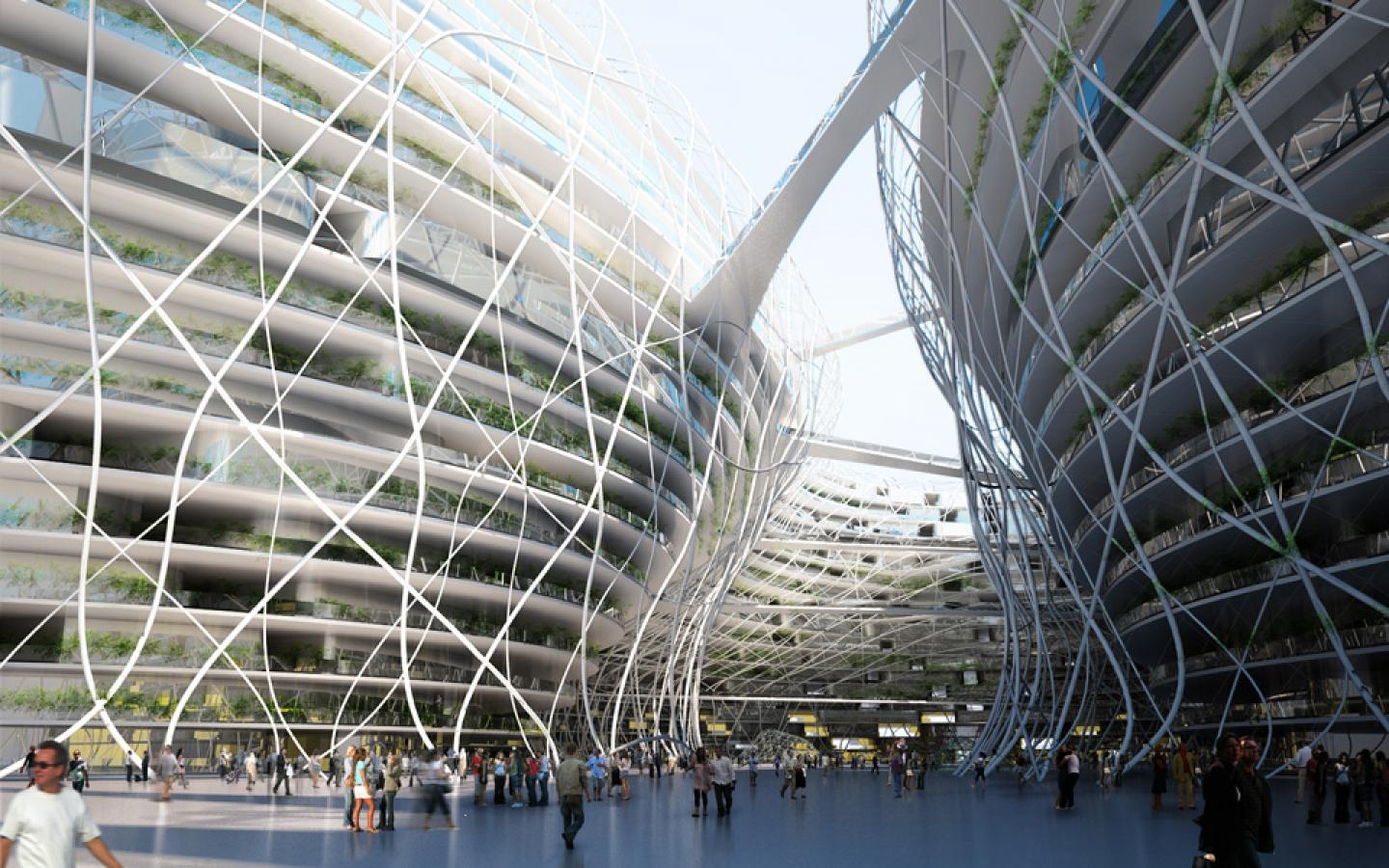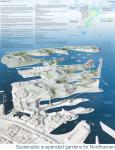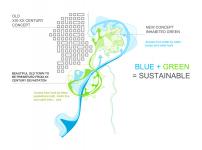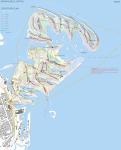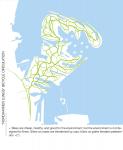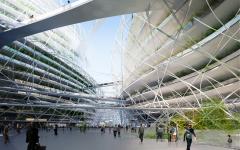Conversion of the Industrial zone of Northern Harbour in Copenhagen, into a new urban development area with room for 40,000 residents and 40,000 staff in buildings with a total floor area of 3mln m².
With our whole respect for the valuable findings of the past, suggest a new way where we do not propose » the buildings » anymore, but offer the “Blue” and “Green Areas” to be inhabited by Copenhagen citizens. Instead of high rise buildings with wind turbulences, we suggest some hills with a natural coastal breeze.
I. SITE: Industrial zone of the Northern Harbour in Copenhagen and sea reclamation area.
CONCEPT: BEE HIVE
On the existing industrial site of the Nordhavnen and reclaimed from the sea additional area, we propose the inhabited green hills based on the image of a bee hive or ant hills, where we create a new urban natural environment, the space where it will be pleasant to spend time, living a happy life, working and relaxing. The feeling enhanced by being able to live together with family and friends in harmony with Nature…where it will be no more necessary to drink to forget the “Modern City”.
What is the “Modern City” now? It is a dead and stagnant collection of stones and concrete walls, and of sometimes even fashionables but mainly pretentious boxes.
It should become a living organism which forms part of the Nature and where its inhabitants are the fully entitled actors of every day life, functioning as her integral part.
DENSE CITY
There is no need of classical towers to ensure the higher density in the city. Our terraced green structures will present a natural landscape without presence of the boxes and cubicles to offer a new dense habitat for the city of Copenhagen.
GREEN SPACES
1- Wetland areas with biological diversity already existing on site are to remain untouched
2-Creation of “corridors” for plants and animals
3-Creation of on-grade green areas for visitors with nature rooted fittings:
-pocket parks close to the build-up areas
-water parks close to the beaches and water sport facilities
-green connections as a link spaces between the natural and artificially created spaces
4-Creation of up-grade green areas with collectively and individually cultivated greenery as suspended gardens
The goal to obtain the most bicycle-friendly city in the world will be achieved by a progressive elimination of car drivers by developing more metro, bicycle paths, water-taxis and water-busses.
2009
II. WATER:
THE THINKING METROPOLIS
A. Think Blue - The City at the water:
- Preservation of the existing biotope on the site
- Development of the sustainable city water communication ways: water-taxis, ferry, water busses, large and small scale boats for goods transportation.
- Sea waves energy generation
- Housing on floating islands
- Creation of housing swimming baths along the waterfront
The integration of planted terraced structures within a waterfront context will create a unique opportunity to organize a new city concept based on use of water, wind and sun, strengthening the communication network and bringing a structure supporting the flexibility of planning in four dimensional spaces. The fourth dimension is time…
B. Think Green:
A model of the sustainable city as Suspended Gardens City where we:
- Respect the existing natural fittings
- The CO² emissions will be reduced by application of clean and renewable energies (windmills, biogases, heat pumps, solar collectors, and sea wave hydroelectric energy), application of green filters...
- Communication and accessibility are enhanced thanks to the densification, proximity and mix of various functions (less energy & less transport)
- Sustainable management of water policy (re-use of grey waters, rain water recuperation, water transport ways...).
III. ENERGY POLICY
1- Reduce demand for energy
Passive design measures such as solar control and natural ventilation will be used to reduce the total energy demand.
2- Use energy in an efficient manner,
Highly efficient plant equipment will be used, including technologies such as CHP, heat recovery and sophisticated control systems.
3– Incorporate renewable sources of energy.
Solar thermal systems can be used to supplement heating and hot water demand for the site. Tidal, wind and micro hydro power plants will use the local natural resources to produce electrical energy. The thermal energy stored in the sea/ground can be used to provide a low energy source of heating/cooling.
IV. HEALTH - CLEAN CITY
POLLUTION
Thanks to the clean and healthy individual and mass transportation means (metro, bicycles, water-taxis and waterbuses…) the CO² emissions and particles pollution will drastically decrease along with noise pollution.
The terraced gardens will enable every inhabitant to ensure his own vegetable production…The easy access to sea food collected in a clean sea waters will considerably contribute to the every day healthy life.
TRASH MANAGEMENT
1-Collection
Consumable items are to be reused on site where possible. Residents should be able to dispose of and collect items such as books, clothes, CDs etc. from local ‘swap shop’ facilities. Non-reusable waste should be separated to recycle as much as possible: plastics, glass, biodegradable waste, paper etc.
2-Treatment
By reusing where possible, the volume of waste to be treated can be reduced. Recycling and non-recyclable waste will be collected and taken to off-site facilities as required.
V. ENVIRONMENTALY FRIENDLY MATERIALS
STRUCTURAL SYSTEMS
1- Bearing walls and columns will be located in such a way that transfer structures will be minimised in order to maximise efficiency and minimise material use.
2- The use of recycled aggregates and cement replacement materials will be considered for the floor slabs.
3- Foundations are likely to consist of piles. Reuse of any existing foundations will be considered at feasibility stage.
For the structural elements, we propose the locally produced steel and wood, gabion walls and reclamation of the sea from broken concrete and …following the evolution in time, other new structural elements which could be proposed.
For other materials such as water tightness membranes, textiles, insulation, glazing and other, we will also follow the local production to avoid costly and polluting transportation.
Many materials may be recuperated from the existing stock and re-used in other forms and applications.
Specific research should be done in this area to cleanout the existing stock and prepare the basis for the new sustainable urban environment.
VI. EQUITY
C. Think Diversity:
- The city for every one where variation will generate a vibrant life (multi-cultural and multi-generational)
- Make house prices available for everybody and diversify the social composition of created clusters.
- Mix of various urban functions: housing, commerce, cultural, education, production...
VII. BEAUTY
D. Think New - The Dynamic City:
- International City of knowledge
- Better synergy between knowledge, environment & industry
- More international students & knowledge workers
This entire programme is possible thanks to the created model of the
Multi-functional complex where based on the image of a bee hive or the ant hill, all inhabitants and users are implicated in a life motion of 24 hours per day and 7 days per week. An environment with an ambience of suspended gardens where it will be pleasant to work, to live, to study and to enjoy this natural cluster created in harmony with Mother Nature.
SUSTAINABILITY
1- Reduce the site wide carbon emissions through energy efficiency and renewable technology, becoming energy friendly, developing sustainable transportation, using renewable and alternative energies (wind, geothermal, solar…)
2- Reduce potable water consumption though efficient fittings, rainwater and/or grey water harvesting.
3- Consider local and global environmental impact by evaluating materials selection, waste management, air & water quality etc.
HOW THE CONCEPT IS ADAPTABLE TO THE UNPREDICTABLE FUTURE?
Global warming may provoke some unpredictable conditions such as the rising of sea level – we propose:
1- To bring more chances to cope with this problem by rising the base of the developed cluster on 6m high piles in order to prevent the possible flooding of its essential features.
2- The form of the terraced sloped morphology creates underneath shaded and, naturally ventilated volumes. This will prevent overheating in the summer season in a sustainable way without using sophisticated devices and fossil energy.
3- Use of clean and renewable energies will enable this cluster to become totally energy-independent.
4- Demographic evolution may modify the living units composition. These modifications are part of our program and the created bee hive like structures enable such flexibility and evolution.
Boguslaw WITKOWSKI - Team Leader
Daniel GOLA - Design Assistant
Tim Thornton - Sustainability Consultant
Elmar HESS - Structural Consultant
